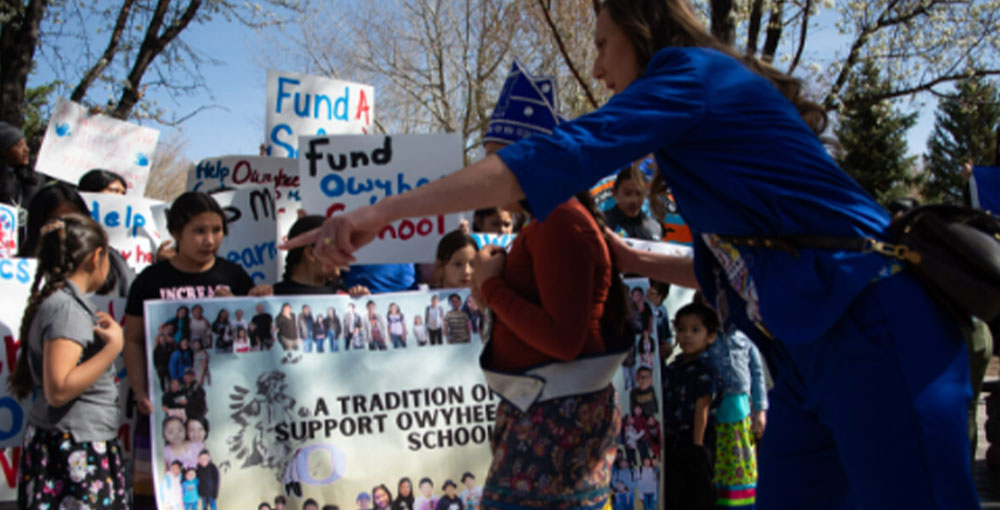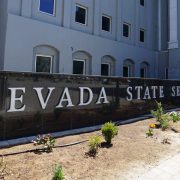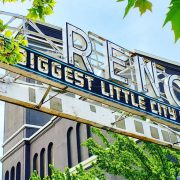This story has been translated to Spanish. You can read it here.
Owyhee Combined School Vice Principal Lynn Manning-John stood on the Nevada Capitol lawn Thursday in front of her students — her “babies” — from the Duck Valley Indian Reservation in northeastern Nevada, a community she grew up in and returned to after attending an East Coast college.
The students, many wearing ribbon skirts and shirts, carried signs with a common theme: “don’t leave us behind.” Among them was her daughter, a senior at the school who was recently admitted to Tufts University, an elite research institution in Boston.
“We have produced some phenomenal kids out of Owyhee,” she said. “But I have to tell you, we do it in some really hard-to-describe conditions.”
The Owyhee Combined School is located on the Shoshone-Paiute Tribes of the Duck Valley Indian Reservation in northeastern Nevada, along the Nevada-Idaho border. Built in the 1950s, the school serves about 300 students. Administrators and teachers at the school described bat feces dripping from the ceilings, and old equipment making it impossible to consistently regulate classroom temperatures, among other conditions that they said have not been addressed by the school district, despite maintenance requests.
“No other school in the state of Nevada would have that type of condition acceptable to students,” said Manning-John.
Her comments came during a Thursday press conference outside the Legislative Building calling attention to the need for a new school. Other speakers, including tribal Chairman Brian Mason, health care officials and community leaders, also highlighted the health risks posed by toxic hydrocarbon plumes that federal regulators found are located under the town and are suspected to be linked to unusually high rates of cancer-related deaths of past students and educators.
The school is part of the Elko County School District, but its Special Services Director Ken Higbee has said it doesn’t have the funds needed to build a new school. In 2021, Elko County voters rejected a proposed measure that would have allowed the district to take out $150 million in bonds to pay for the construction of a new elementary school, remodeling projects and more.
The tribe has projected that the overall cost for the construction of a new school will be $77 million and has committed $15 million for infrastructure expenses. The tribe still needs $62 million for remaining building costs.
During a hearing with lawmakers last month, district Human Resources Director Cody Krenka said with nonexistent capital funds, their remaining dollars need to be spread out until voters act to replenish the infrastructure accounts.
“The priorities of Owyhee are the exact same as the priorities of Wendover,” he said. “Those old schools, when boilers break down, we go to fix them.”
The district said in a statement it supports the tribes’ efforts and takes staff and student safety seriously. It also added it believed the tribes and the Bureau of Indian Affairs were still trying to determine whether, and to what extent, the hydrocarbon contamination affects the school.
“In the event any environmental threats are identified at the school, swift action will be taken to address the matter,” the district said. “At this time, the district has no direct knowledge of any such threats, but will continue to monitor the situation.”
Members of the tribe have now turned to the Legislature for aid.
This session, Assemblywoman Alexis Hansen (R-Sparks) proposed a measure, AB273, that would allocate more than $65 million in funds to the Elko County School District for a new school, but its fate is tenuous — it has an exemption from legislative deadlines, but has yet to come up for a hearing in the Assembly budget committee.
At the same time, members of Democratic leadership have been meeting with tribal leaders, and say they are committed to addressing the issue, though no formal plan or funding mechanism to do so has yet come forward. Those conversations have included discussions about finding ways to more systematically fund schools on tribal land.
“We are aware of the situation involving the Owyhee school and are currently looking at different proposals to find the best solution for this issue,” said Assembly Speaker Pro Tempore Daniele Monroe-Moreno (D-North Las Vegas), who also chairs the Assembly’s budget committee.
Senate Majority Leader Nicole Cannizzaro (D-Las Vegas) told The Nevada Independent she met with Chairman Mason Thursday and “assured him that Legislative Democrats are committed to working with the tribal community to find a solution.”
“The condition of the Owyhee Combined School is unacceptable,” she said. “I am immensely disappointed in Elko County for their failure to maintain a safe learning environment for students, educators, and support staff.”
One bill lawmakers could potentially amend to add funding for a new school is SB10, a measure sponsored by the treasurer’s office that includes a $50 million appropriation to support rural school construction.
‘Hazardous and frigid environments’
Along with a colony of bats living in the school’s ceiling, Manning-John described how the building lacks air conditioning, which forces school officials to open screen-less windows during the summer, inviting mosquitoes and wasps into classrooms. Manning-John also said the school has had perpetual problems with its boiler, and frequently relies on space heaters for warmth in the winter — a fire risk.
Leilani Thorpe, a descendent of the Shoshone-Paiute Tribes in Owyhee and parent of four children at the school who range from 5 to 17 years old, said the heating issue has existed since she and her mom attended the school. She said classes have been canceled countless times because the boiler stopped working.
“How are our kids supposed to learn in these hazardous and frigid environments?” she said.
Manning-John estimates that the cost to repair the existing school, which she said is past its useful life, would exceed the cost of a new building.
The school’s location poses another type of safety risk for students and educators.
The school neighbors State Route 225, which Manning-John said results in drivers coming onto the school campus to use the bathroom. Guns are also a large part of the school’s rural community, and Manning-John said some “wily” gun owners have “taken a shot at the school” as evidenced by the bullet holes in the awning.
Manning-John also worries about how easy it would be for someone to come on to the campus by breaking through the school’s glass front doors, especially after seeing how a shooter broke into a Nashville private school in late March.
“My office is the first door on the other side of that glass door, and I’ve told my kids, and I’m telling all of you, if that horrible day comes, I’m first,” she said, tears in her eyes.
If funding were to be approved for a new school, Manning-John said it could be planted in the nearby community of Newtown, which is located about three miles outside of Owyhee, away from the highway and the hydrocarbon plume.
She estimates about half of the school’s students reside in that community, which would make the new site walkable for them. She also envisions the potential new school as a welcoming space for all students and their family members.
“Every person, every student who came in that building could come as a whole Native student,” she said. “They would not have to shed that identity in order to enter our building.”
Fifth grader Landon Lee said the new site could also include a new basketball court and space for the school’s award-winning robotics team, which currently meets at its coach’s home.
“A new school basketball court inside and outside would mean the world to me and my friends,” Lee said.
Sixth grader Uriah Tobey said his community deserves a new school for the future of the tribe.
“We are the next leaders,” he said. “A new school would give us motivation to take our education and future more seriously. We can have higher expectations for ourselves to graduate and go on to college.”
Correction: April 28, 2023. A previous version of this article misstated the identity of Leilani Thorpe. She’s a descendent of the Shoshone-Paiute Tribes in Owyhee.







